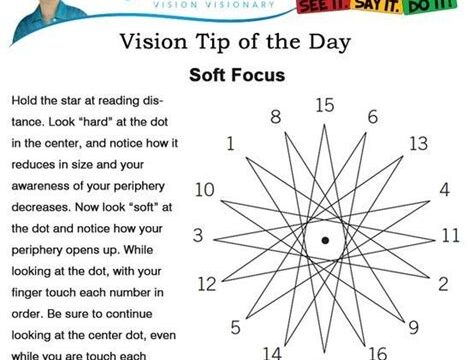Utilizing low vision aids for reading
Utilizing low vision aids for reading is crucial for individuals with visual impairments. These aids are designed to magnify and enhance text, making it easier for people with low vision to read and access information. By utilizing these aids, individuals with visual impairments can improve their reading skills and gain greater independence in their daily lives.
One of the most commonly used low vision aids is a magnifying glass. This handheld device can be used to enlarge text, making it easier to read. Magnifying glasses come in various sizes and strengths to accommodate different levels of visual impairment. Another popular low vision aid is a magnifier with a built-in light. This type of magnifier not only magnifies text but also provides additional illumination, enhancing visibility.
In addition to handheld magnifiers, there are also electronic magnifiers available. These devices use cameras to capture text and display it on a screen in a larger, more readable format. Electronic magnifiers often offer additional features such as adjustable magnification levels, color contrast options, and image capture capabilities. Some electronic magnifiers can even read text aloud using text-to-speech technology, further enhancing accessibility.
- Magnifying glasses
- Magnifiers with built-in lights
- Electronic magnifiers with adjustable magnification levels and text-to-speech technology
Another type of low vision aid is a video magnifier. Video magnifiers consist of a camera connected to a monitor or computer screen. They allow individuals with low vision to view and magnify printed materials, such as books, newspapers, or documents. Video magnifiers offer greater flexibility in terms of magnification levels and customization options. Some video magnifiers also come with text-to-speech capabilities, making them even more versatile and useful for individuals with visual impairments.
| Advantages of low vision aids for reading | Disadvantages of low vision aids for reading |
|---|---|
| – Enhanced visibility of text | – Costly investment |
| – Improved reading speed | – Learning curve for using electronic magnifiers |
| – Increased independence in reading | – Limited portability for larger devices |
| – Customizable settings for individual needs | – Dependence on technology |
Utilizing low vision aids for reading can greatly enhance the reading experience for individuals with visual impairments. These aids provide increased visibility, improved reading speed, and greater independence in accessing information. While there may be some disadvantages, such as the cost of certain devices or the learning curve associated with electronic magnifiers, the benefits far outweigh the challenges. By embracing these low vision aids, individuals with visual impairments can enjoy reading and continue to expand their knowledge and horizons.
Improving reading skills through visual training
Reading is a fundamental skill that plays a crucial role in our daily lives. However, for individuals with visual impairments, accessing and comprehending written information can be a challenging task. Fortunately, there are various methods and techniques available to enhance reading skills through visual training. In this blog post, we will explore some of these strategies that can contribute to improving reading abilities for individuals with visual impairments.
One effective approach to improve reading skills is utilizing low vision aids. These aids, such as magnifiers and high-contrast filters, can help individuals with low vision to overcome visual challenges and enhance their reading experience. For example, using a handheld magnifier can enlarge text and make it easier to read. Additionally, incorporating high-contrast filters, which darken the background and increase the brightness of the text, can improve visibility and reduce eye strain.
Visual training exercises and techniques are another valuable tool in improving reading skills. These exercises aim to enhance visual processing, tracking, and attention, which are crucial for efficient reading. One technique is using visual tracking exercises, where individuals follow moving objects with their eyes. This helps improve their eye movements and tracking abilities, enabling smoother and more accurate reading. Another technique is incorporating list and table tags in reading materials. Including bulleted or numbered lists and organized tables can help visually impaired individuals better understand and comprehend information. This structured format provides a clear visual organization, making it easier to locate and absorb key points.
Assistive technology for enhancing reading abilities
Assistive technology plays a crucial role in enhancing reading abilities for individuals with visual impairments. With the advancements in technology, there are now numerous tools and devices available that are specifically designed to assist individuals with visual impairments in improving their reading skills. These assistive technologies not only make reading more accessible but also help individuals with visual impairments to read with greater ease and efficiency.
One of the most commonly used assistive technologies for enhancing reading abilities is optical character recognition (OCR) software. OCR software is designed to scan printed text and convert it into digital text format. This technology enables individuals with visual impairments to access printed materials by converting them into digital formats that can be read using text-to-speech software or Braille displays. This opens up a world of reading possibilities for individuals with visual impairments, allowing them to read books, articles, and other printed materials.
Another assistive technology that can enhance reading abilities is electronic magnifiers. These devices are designed to magnify text or images, making them easier to read or view for individuals with low vision. Electronic magnifiers come in various forms, including portable handheld devices and desktop magnifiers. Some even have features like text-to-speech capabilities, allowing individuals with visual impairments to both magnify and listen to the text simultaneously.
In addition to OCR software and electronic magnifiers, advanced screen reading software is another powerful assistive technology for enhancing reading abilities. Screen reading software uses text-to-speech synthesis to read out the content displayed on a computer screen or mobile device. This technology enables individuals with visual impairments to access digital content such as websites, emails, and documents. With the ability to adjust reading speed and customize settings, individuals can optimize their reading experience according to their preferences.
- OCR software: Scans printed text and converts it into digital formats
- Electronic magnifiers: Magnify text or images for individuals with low vision
- Screen reading software: Reads out digital content using text-to-speech synthesis
| Assistive Technology | Features |
|---|---|
| OCR software | Converts printed text into digital formats |
| Electronic magnifiers | Magnifies text or images |
| Screen reading software | Reads out digital content |
Adaptive techniques for navigation and mobility
When it comes to navigation and mobility, individuals with visual impairments often face unique challenges. However, thanks to advances in technology and adaptive techniques, there are now various methods available to assist them in navigating their surroundings more independently. In this blog post, we will explore some of the adaptive techniques that can greatly enhance the navigation and mobility skills of visually impaired individuals.
One of the most commonly utilized techniques for navigation and mobility among individuals with visual impairments is the use of a white cane. The white cane is a long, lightweight stick that is held diagonally across the body and is swept back and forth in front of the person while walking. This technique allows visually impaired individuals to detect obstacles in their path and navigate around them safely. The white cane also serves as a visual cue to alert others to the person’s visual impairment, ensuring greater awareness and accommodation.
In addition to the white cane, auditory cues play a crucial role in improving mobility for visually impaired individuals. Utilizing auditory cues involves relying on sounds and verbal instructions to navigate and gain awareness of the surrounding environment. For example, auditory traffic signals can help visually impaired individuals cross the road safely by indicating when it is safe to walk or stop. Similarly, utilizing auditory cues from public transportation announcements and smartphone navigation apps can assist in navigating unfamiliar places, enabling visually impaired individuals to travel with greater confidence.
Besides white canes and auditory cues, another adaptive technique that can greatly enhance navigation and mobility for individuals with visual impairments is the use of spatial awareness and depth perception. Developing spatial awareness involves understanding and interpreting the relationship between objects and spaces in the surrounding environment. This can be achieved through specific training techniques, such as learning how to judge distances, recognize landmarks, and understand the layout of different spaces. By enhancing spatial awareness and depth perception, visually impaired individuals can navigate their surroundings more effectively and confidently.
To summarize, adaptive techniques play a crucial role in improving navigation and mobility for individuals with visual impairments. Utilizing tools such as white canes, auditory cues, and spatial awareness training can greatly enhance their independence and confidence in navigating their surroundings. By continuously exploring and embracing these adaptive techniques, visually impaired individuals can overcome challenges and lead more fulfilling lives.
Orientation and mobility training for visually impaired
Orientation and mobility training plays a crucial role in empowering visually impaired individuals to navigate the world around them with confidence and independence. This type of training focuses on teaching individuals how to orient themselves to their surroundings and move safely and effectively through their environment. By equipping them with the necessary skills and techniques, orientation and mobility training enables visually impaired individuals to overcome physical and cognitive barriers, ultimately enhancing their overall quality of life.
One key aspect of orientation and mobility training is teaching individuals how to effectively use sensory cues to understand their surroundings. This involves utilizing auditory cues, such as sound landmarks and traffic patterns, to gather information about the environment. By actively listening and using these cues, visually impaired individuals can better navigate their surroundings and anticipate potential obstacles or dangers.
In addition to utilizing auditory cues, individuals undergoing orientation and mobility training also learn to rely on their other senses, such as touch and proprioception, to gather information about their surroundings. For example, learning to use a white cane or a guide dog can provide individuals with valuable tactile feedback, allowing them to detect changes in terrain, locate obstacles, and determine the layout of their environment.
Furthermore, orientation and mobility training often incorporates the use of assistive technology to enhance individuals’ navigational abilities. For instance, GPS devices specifically designed for the visually impaired can provide real-time information about one’s location and help individuals plan their routes more effectively. Other technological aids, such as electronic travel aids or accessible mobile applications, can also assist visually impaired individuals in navigating unfamiliar environments or public transportation systems.
Table of Contents:
- Introduction to Orientation and Mobility Training
- The Importance of Sensory Cues in Navigation
- Utilizing Assistive Technology for Enhanced Mobility
- Case Studies: Success Stories in Orientation and Mobility Training
- Conclusion: Empowerment through Orientation and Mobility Training
Utilizing white canes for independent mobility
Utilizing White Canes for Independent Mobility
For visually impaired individuals, maintaining independence in their daily lives is crucial. One of the most effective tools for achieving independent mobility is a white cane. White canes provide essential support and assistance, enabling individuals with visual impairments to navigate their surroundings with confidence and ease. This blog post will explore the benefits of utilizing white canes for independent mobility and discuss how these tools can enhance the quality of life for visually impaired individuals.
White canes serve as a valuable aid for individuals with visual impairments, offering both physical and psychological benefits. Physically, the cane acts as an extension of the user’s sense of touch, allowing them to detect obstacles, changes in elevation, and uneven terrain. By tapping the cane in front of them as they walk, individuals can identify potential hazards and adjust their path accordingly. This tactile feedback enhances safety and helps prevent accidents or injuries.
In addition to the physical benefits, white canes also provide a psychological sense of independence and confidence for visually impaired individuals. By using a cane, individuals can assert their presence in an environment and signal to others that they have low vision or blindness. This visibility helps to create awareness among people around them and facilitates smoother interactions. Moreover, by actively participating in their surroundings, individuals experience a greater sense of control and autonomy over their movements.
- Increased safety: White canes enable individuals to detect and avoid obstacles, ensuring their safety while navigating various environments.
- Improved confidence: Utilizing a white cane empowers individuals with visual impairments, enhancing their self-esteem and overall confidence.
- Enhanced independence: With the assistance of a cane, visually impaired individuals can move around independently without relying solely on assistance from others.
- Greater social interaction: The use of a white cane signals to others that an individual has low vision or blindness, fostering understanding and enabling smoother interactions.
- Ability to explore new environments: By utilizing a cane, individuals can confidently explore and navigate unfamiliar places, expanding their horizons and participating in various activities.
| Types of White Canes | Description |
|---|---|
| Symbol Cane | A basic cane designed to indicate low vision or blindness. |
| Foldable Cane | A portable and convenient option that can easily be folded and carried in a bag or pocket. |
| Telescopic Cane | An adjustable cane that can be shortened or extended to suit the user’s desired length. |
| Sensor Cane | A technologically advanced cane that uses sensors to detect obstacles and provide auditory or vibratory feedback. |
White canes are available in various types, allowing individuals to choose the option that best suits their needs and preferences. Symbol canes are the most common type, providing a simple indicator of low vision or blindness. Foldable canes offer practicality and convenience for those who frequently travel or need to store their cane when not in use. Telescopic canes offer adjustability, allowing users to set the length according to their height and comfort. Sensor canes, on the other hand, incorporate advanced technology to detect objects and provide feedback, further enhancing safety and mobility.
In conclusion, white canes play a vital role in promoting independent mobility for individuals with visual impairments. Through the physical support and psychological empowerment they provide, white canes enable visually impaired individuals to navigate their surroundings confidently and safely. By utilizing a white cane, individuals with low vision or blindness can experience increased freedom, explore new environments, and actively participate in various activities, ultimately enhancing their overall quality of life.
Enhancing spatial awareness and depth perception
In order to navigate and move around confidently, individuals with visual impairments need to have a strong sense of spatial awareness and depth perception. Spatial awareness refers to the ability to understand and interpret one’s position in relation to the surrounding environment, while depth perception enables us to perceive the distance between objects. These skills are essential for independent mobility and can be enhanced through various techniques and strategies.
One effective way to enhance spatial awareness and depth perception is through the use of auditory cues. By incorporating sound cues into the environment, individuals with visual impairments can gain a better understanding of their surroundings. For example, installing motion-activated audio devices that emit different sounds depending on the proximity to obstacles or landmarks can help individuals detect and locate objects in their path.
Another technique that can enhance spatial awareness is the use of tactile maps and models. Tactile maps are raised, textured representations of an area or a building that allow individuals to feel and explore the layout and features. By involving touch, individuals can develop a mental image of the space and better understand the spatial relationships within it. Similarly, tactile models of objects or landmarks can provide a three-dimensional representation, allowing individuals to comprehend the depth and structure of the objects in question.
- Utilizing auditory cues for improved mobility
- Enhancing spatial awareness through tactile maps and models
- Using technology to enhance spatial awareness and depth perception
| Cues and Techniques | Benefits |
|---|---|
| Audio cues | Improved object detection and localization |
| Tactile maps and models | Enhanced understanding of spatial relationships |
| Assistive technology | Access to virtual environments and simulations for practice |
Additionally, assistive technology can play a significant role in enhancing spatial awareness and depth perception. Virtual reality (VR) and augmented reality (AR) technologies provide immersive experiences that can simulate real-life environments and situations. By using these technologies, individuals with visual impairments can practice navigating unfamiliar spaces, hone their orientation skills, and improve their depth perception in a safe and controlled environment.
In conclusion, enhancing spatial awareness and depth perception is crucial for individuals with visual impairments to achieve independent mobility. Through the use of auditory cues, tactile maps and models, and assistive technology, individuals can develop a better understanding of their surroundings and improve their ability to navigate confidently. By exploring and utilizing these techniques, individuals with visual impairments can enhance their overall mobility and independence.
Integrating auditory cues for improved mobility
When it comes to navigating the world, those who are visually impaired face unique challenges. However, with the advancements in technology and training techniques, there are now various assistive tools available to enhance their mobility. One such technique that has proven to be effective is the integration of auditory cues. By utilizing sound as a means of gathering information about their surroundings, individuals with visual impairments can significantly improve their mobility and independence.
One of the key benefits of integrating auditory cues is the ability to gather information about objects and obstacles in the environment. By using tools such as audio sensors or sonar devices, individuals can detect the presence of objects by the sound they emit. For example, a sonar device may produce different pitches or tones based on the distance or proximity of an obstacle. This allows the person to navigate around it and avoid potential accidents.
In addition to object detection, auditory cues can also be used for orientation and wayfinding. For instance, audio GPS systems provide step-by-step auditory directions, allowing individuals to navigate unfamiliar areas with ease. These systems can also provide information about nearby landmarks, bus stops, or other points of interest, enabling visually impaired individuals to travel independently and confidently.
Furthermore, auditory cues can be integrated into mobility training programs to improve spatial awareness and depth perception. By using audio feedback, individuals can better understand the layout of their surroundings and develop a mental map of the environment. This allows them to move around with greater confidence and accuracy.
Overall, integrating auditory cues into assistive technology and mobility training programs can greatly enhance the mobility and independence of individuals with visual impairments. By using sound as a valuable source of information, they can navigate their surroundings with ease, detect obstacles, and improve their overall spatial awareness. Through advancements in technology and proper training, the integration of auditory cues is revolutionizing the way visually impaired individuals navigate and interact with the world around them.
Frequently Asked Questions
1. How can low vision aids help improve reading skills?
Low vision aids such as magnifiers, text-to-speech software, and large print materials can help individuals with visual impairments enhance their reading abilities by making text more accessible and easier to read.
2. Can visual training improve reading skills in individuals with low vision?
Visual training exercises and therapies can help individuals with low vision improve their reading skills by enhancing their visual processing abilities, eye movement control, and attention to detail.
3. What are some examples of assistive technology for enhancing reading abilities?
Some examples of assistive technology for enhancing reading abilities include screen readers, optical character recognition software, braille displays, and electronic magnifiers.
4. How can adaptive techniques help with navigation and mobility for individuals with visual impairments?
Adaptive techniques such as using a white cane or guide dog, learning orientation and mobility skills, and utilizing auditory cues can help individuals with visual impairments navigate and move around independently and safely.
5. What is the importance of orientation and mobility training for visually impaired individuals?
Orientation and mobility training is crucial for visually impaired individuals as it teaches them skills and techniques to orient themselves in their environment, navigate unfamiliar places, and move around safely and independently.
6. How can the use of white canes improve independent mobility for individuals with visual impairments?
White canes provide individuals with visual impairments tactile feedback about their surroundings, help detect obstacles, and signal to others that they have a visual impairment, thus promoting safe and independent mobility.
7. How can integrating auditory cues enhance mobility for individuals with visual impairments?
Integrating auditory cues such as using sound beacons or GPS navigation systems can help individuals with visual impairments better understand their surroundings, locate points of interest, and navigate unfamiliar environments more effectively.





